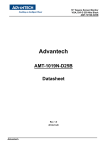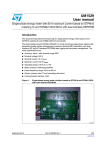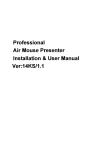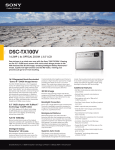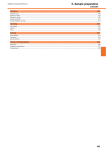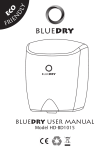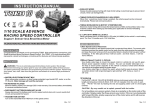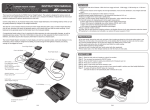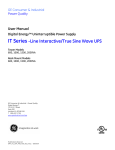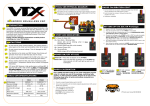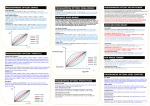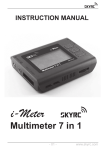Download English Manual - G
Transcript
INSTRUCTION MANUAL For 1/12 Onroad Competition Support Both Sensor or Sensor-less Brushless Motor INTRODUCTION Thank you for purchasing Gforce 1S 120A ESC from G-FORCE, INC. Please read the Instruction Manual thoroughly before you use the product. These operating instructions are designed to ensure that you quickly become familiar with its features and functions and make full use of this product. FEATURES Users could set the turbo and boosting timing which can improve the motor RPM to get its best performance. Well-performed throttle and brake control function could control the punch/brake rate by point and the point can be set by user. The precision of the punch/brake rate is 1. And the user could also custom the throttle/brake curve. Punch control is reasonable and precise and can meet different customers' request for linear and power. Red copper connector is used internal of the ESC. It can decrease the internal resistance at high current situation. The circuit is managed by intelligent thermal management kernel algorithm which can improve driving skill. The dynamic loss can be reduced effectively when the motor is running at high speed or the user changes the motor speed frequently so that the motor can be more stable when running. The internal resistance can be reduced by laminated copper stack control technology so that the dynamic thermal equilibrium can be got. In this case, the aluminum heat sinks can works effectively. The electronic switch is built in so that it could save space. And the electronic switch is more sensitive and reliable. The users could set and store 10 sets of profiles in the ESC. These data could be called out at any time without any special program setting. All the setting can be exported or imported so that the user could compare and analyze. Safety features: low voltage protection, motor and ESC overheat protection and signal lost protection. SAFETY NOTE It is not a toy and suitable for users older than 14 years old. Never allow water, moisture, oil or other foreign materials to get inside ESC, motor, or on the PC Boards. It may damage the ESC completely. Never disassemble the ESC and modify the components on the PC Boards. Suggest using the original wires and connectors which are packed in the box. Never solder one part for more than 5 seconds as some components will get damaged by high temperature. Never run the ESC w/o load at full throttle and it may damage the bearings and other moving parts. Please make sure the location where to fix the ESC has good airflow ventilating so that the heat could dissipate quickly. To avoid short circuit, please keep the ESC connectors far away from other metal parts. Never connect the battery in polarity in reverse. Please remove the pinion gear before performing calibration and programming functions with this system. Please keep your hands, hair, cloth, clear from the gear train and wheels. Before you switch on the ESC, please make sure all the cables are well solder with the connectors (It is easy to get loose when running) . What's more, make sure the cables not touch the moving parts. Electronic motor timing will increase the temperatures of ESC and brushless motor. Use extreme caution when setting up and testing your application to avoid overloading and overheating. Incorrect Boost and Turbo timing setting may cause permanent damage to the ESC and motors. Please choose proper ratio and timing setting according to motor's instruction. To avoid signal interference, please always turn on the transmitter first THEN turn on the speed control. Do the opposite when powering it off. Never use faulty accessories, e.g. motor which may damage the ESC. Always insulate exposed wiring with heat shrink tubing or electrical tape to prevent short circuits, which can damage ESC too. Always disconnect the battery pack from the speed control when not in use to avoid short circuits and possible fire hazard. When the ESC is switched off, there is still small current and it may cause over discharge of the battery after some time. The ESC can support 1 cell LiPo battery only. ESC CALIBRATION 1) Plan Speed Control Placement Choose a location for the speed control that is protected from debris. To prevent radio interference, place the speed control as far away from the radio receiver as possible and keep the power wires as short as possible. Select a location that has good airflow ventilating. If the ESC gets air flow, it will run cooler; and that means it will be more efficient. 2) Mount Speed Control in Vehicle Use double-sided tape to mount the speed control in vehicle (do not use CA glue). 3) Soldering Cut the ESC's BLUE, YELLOW & ORANGE silicone motor power wires to the desired length and strip about 3.2mm-6.35mm (1/8”-1/4”) of insulation from the end of each wire. “Pre-tin”the wire by heating the end and applying solder until it is thoroughly covered. CAUTION: By very careful not to splash yourself with hot solder. Place the ESC's BLUE Phase ‘A’ motor wire onto motor's ‘A’ solder tab and solder. Use soldering iron to apply heat to exposed wire; begin adding solder to tip of soldering iron and wire. Add just enough solder to form a clean and continuous joint from the plated area of the solder tab up onto the wire. Solder the ESC's YELLOW Phase‘B’ motor wire to the motor's ‘B' solder tab and Solder the ESC's ORANGE Phase ‘C' motor wire to motor’s ‘C’ solder tab. CONNECTION 1) Connect the motor sensor harness to ESC. Insert the 6 pin connector on the end of the motor's sensor wires into ESC's sensor harness socket. 2) Connect Throttle lead to ESC and other end to the Receiver (Throttle Channel, Ch2) 3) Solder the motor and the ESC. 4) Connect ESC to battery pack. Black power wire Red power wire (battery positive) (battery negative) Throttle lead Receiver Note: We will not be responsible for any damage caused by non-compliance with above instruction. Battery Pack Calibration is necessary for the first use of the ESC, or whenever used with a new/different transmitter. Individual transmitter's signals for full throttle, full brake and neutral vary. You must calibrate your ESC so that it will operate more effectively with your transmitter. How to calibrate the ESC? ESC switch OFF. Connect the ESC to the battery and the motor. Turn on the transmitter. Press and hold the ESC switch for few seconds, the motor will ring long beep once. After that, the red LED will blink the motor will ring like beep-beep-beep… in a row which indicates it is time to set the neutral position, full throttle and full brake one by one. You could release the ESC switch now. Keep the throttle trigger in neutral position, press the ESC switch once, the green LED will blink once then extinguish and the motor will ring beep once which indicates the neutral position has been set. Hold full throttle and press the ESC switch once, the green LED will blink twice then extinguish and the motor will ring twice like beep-beep which indicates the full throttle has been set. Move the throttle trigger to full brake and hold full brake, press the ESC switch once, the green LED will blink three times then extinguish and the motor will ring three times like beep-beep-beep which indicates the full brake has been set. After the calibration is finished, keep the throttle in neutral position, the red LED will stay ON, the ESC and the motor is ready to work. ESC ON/OFF AND LED INDICATOR 1. ESC ON/OFF: When the ESC is OFF, press the switch once, the motor will ring beep once and the red LED will stay on (Motor boost and turbo timing is on), then the ESC is ready to work. When the ESC is on, press the switch once, the LED will extinguish and the ESC is OFF. Note 1: After running at full load, the ESC will be very hot. In this case, please turn off the ESC after it cools down. Note 2: When the motor is running, the ESC can't be powered off by pressing the switch; when the motor stops working, the ESC can be powered off. In an emergency, please disconnect the battery to power off the ESC. Note 3: When the motor is running, keep the trigger of the transmitter to full brake for 8 seconds, the ESC will be off. Power Switch 2. Explanation of LED Indicator Bluetooth Module (Optional part) The firmware can be updated by connecting the ESC with PC. It can be off by keeping the trigger to full brake for 8 seconds when running. 1/8 PREPARATION Yellow motor phase wires (phaseB) Motor Sensor Wire 2/8 Blue motor phase wires (phaseA) 3/8 Orange motor phase wires (phaseC) The throttle trigger is in neutral position Red LED is blinking (zero timing) The throttle trigger is in neutral position Red LED stays on (Motor boost and turbo timing is on) The motor is running while the throttle trigger doesn’t reach to the highest throttle/brake position Green LED is blinking. The throttle trigger is at the highest throttle/brake position. Green LED stays ON 4/8 ESC PROGRAMMING Programmable Items and Description The ESC can be programmed by program box or PC(connecting by program box). Section How to program the ESC? Red power wire (battery positive) General Setting Battery Pack Throttle Control Black power wire (battery negative) Power Switch Brake Control OR To PC Boost Timing Turbo Timing Program Item Running Mode Motor Direction Reverse Speed Voltage Cutoff ESC Overheat Protection Motor Overheat Protection Punch Rate Switch Point 1st Stage Punch Rate 2nd Stage Punch Rate TH Input Curve Throttle Dead Band Throttle Status Drag Brake Brake Strength Initial Brake Brake Rate Switch Point 1st Stage Brake Rate 2nd Stage Brake Rate Brake Input Curve Boost Timing Boost Start RPM Boost End RPM Boost Liner Slop Boost Constrain by TH Turbo Timing Turbo Activation Method Turbo Full TH Delay Turbo Start RPM Turbo Engage Slop Turbo Deactive Slop Profiles Preset Description Forward/Brake Forward/Brake/Reverse Forward/Reverse Normal Reverse 25-100% (in 1% increment) 3.0-11V (in 0.1V increment), disable Auto (3.2V) 85℃/185℉ 105℃/221℉ 85℃/185℉ 105℃/221℉ 1-99%(in 1% increment) 1-30(in 1 increment) 1-30(in 1 increment) Linear Custom 0.002-0.150ms 125℃/257℉ Disable 125℃/257℉ Disable The users could preset and store 10 sets of profiles in the ESC. These data could be called out for application at any time without any special program setting. The user could also reset the profile according to his request. There is one factory default setting called Modify in the ESC. This mode can be used for modify class of touring car racing. Setting Details of Modify Mode Modify Mode Setting Value Section General Setting 0-100%(in 1% increment) 0-100%(in 1% increment) =Drag Brake 0-50% 1-99%(in 1% increment) 1-20(in 1 increment) 1-20(in 1 increment) Linear Custom 0-64 deg (in 1° increment) 1000-35000RPM (in 500RPM increment) 3000-60000RPM(in 500RPM increment) Linear Custom Yes No 0-64 deg (in 1° increment) RPM Full TH+RPM Full TH 0.01-1.00S(in 0.01S increment) Instant 9000-50000RPM/MIN(in 1000RPM increment) 1deg/0.1S - 64deg/0.1S (in 1° increment) 1-64 deg/0.1S(in 1°increment) Instant Throttle Control Brake Control Boost Timing If you set the cut-off voltage manually, please note the adjustable votage is TOTAL cut-off voltage of the battery pack. In AUTO mode, the default cut-off voltage is 3.0V/S. Note: The output power of the motor will be improved when you adjust the motor timing. Electronic motor timing will increase the temperatures of ESC and brushless motor. Use extreme caution when setting up and testing your application to avoid overloading and overheating. Incorrect Boost and Turbo timing setting may cause permanent damage to the ESC and motors. Please choose proper ratio and timing setting according to motor's instruction. Here is some suggestions about motor timing, Motor Turns Boost Timing Turbo Timing 5/ 8 3.5T/4.0T 0 10 4.5T/5.5T 0 15 6.5T/7.5T 10 45 6/ 8 8.5T/9.5T 15 50 10.5T/11.5T 20 56 Turbo Timing Program Item Running Mode Motor Direction Reverse Speed Voltage Cutoff ESC Overheat Protection Motor Overheat Protection Punch Rate Switch Point 1st Stage Punch Rate 2nd Stage Punch Rate TH Input Curve Throttle Dead Band Throttle Status Drag Brake Brake Strength Initial Brake Brake Rate Switch Point 1st Stage Brake Rate 2nd Stage Brake Rate Brake Input Curve Boost Timing Boost Start RPM Boost End RPM Boost Liner Slop Boost Constrain by TH Turbo Timing Turbo Activation Method Turbo Full TH Delay Turbo Start RPM Turbo Engage Slop Turbo Deactive Slop Description Forward/Brake Normal 25% 3.2V/1S (Auto) 105℃/221℉ SPECIFICATION Constant/Burst Current Motor Compatible Car Compatible Motor Limits Resistance 0.0003ohm Battery Cell Count BEC Output Size Weight 120A/760A Brushless Sensor & Sensorless Motor 1/12 onroad competition 3.5T(3 slots, 2 poles, 540 class motor) 1S LiPo 6V@3A, linear 38.5x37.8x22.5mm (LxWxH) 50g (w/o wire) REMARK: All the testing results are working with 540 class motors with standard timing. 105℃/221℉ 50% 5 15 Linear 0.080ms 10% 75% =Drag Brake 50% 10 16 Linear 0° 15000RPM 25000RPM Linear Yes 10° Full TH 0.10S 20000RPM 48°/0.1S 30°/0.1S Products by G-FORCE, Inc. www.gforce-hobby.jp Mare-kanda Bld.9F, 1-3-1, Kajicho, Chiyoda-ku, Tokyo, 101-0044, Japan ≥13.5T 30 64 Copyright © 2014 G FORCE, Inc. All Right Reserved. 7/ 8 8/ 8




